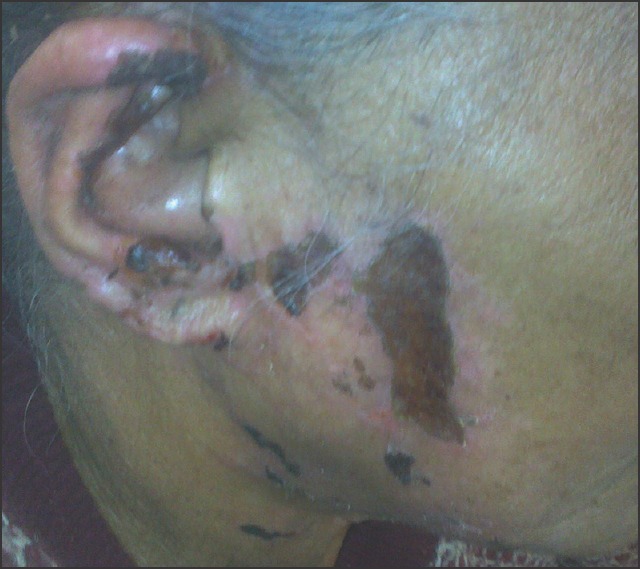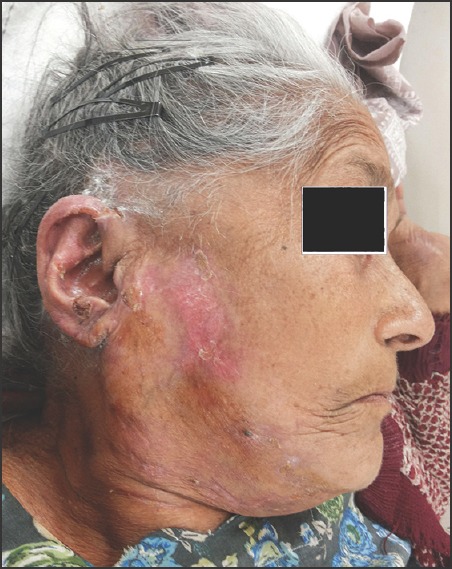Abstract
Ramsay hunt syndrome[1] is a varicella zoster virus infection of the geniculate ganglion of the facial nerve. It is typically associated with a red rash and blister (inflamed vesicles or tiny water filled sacks in the skin) in or around the ear and eardrum and sometimes on the roof of the mouth or tongue. Corticosteroid, oral acyclovir, and anticonvulsant are used for treatment of this. In addition to this sympathetic neural blockade via stellate ganglion block is used to prevent facial nerve damage and relieve symptoms. We present a case of Ramsay hunt syndrome in which pain and symptoms are not relieved by oral medication but by daily sittings of stellate ganglion block with local anesthetic and steroid, pain, and other symptoms are relieved, and facial nerve damage is prevented.
Keywords: Local anesthetic, Ramsay hunt syndrome, stellate ganglion block, steroid
INTRODUCTION
Ramsay hunt syndrome was first described in 1907 by Hunt[1,2] in a patient who had otalgia associated with cutaneous and mucosal rashes. He described it as an infection of the geniculate ganglion by human herpes virus 3. This syndrome is also known as Geniculate Neuralgia or Nervus Intermedius Neuralgia. We report a case of Ramsay hunt syndrome which was initially treated by corticosteroid, oral acyclovir, and anticonvulsant by dermatologist but the pain and itching did not subside. Patient had severe excruciating pain at regular 5-10 min interval. Patient received daily sittings of stellate ganglion block on the right side for 7 days with bupivacaine and steroids initially then with bupivacaine alone in the pain clinic. The aim of presenting this case report was to highlight that stellate ganglion block[3] can prevent facial nerve damage and relieve pain and other symptoms even after oral medication has failed.
CASE REPORT
A 70-year-old female attended dermatology department with a complaint of right ear pain and fluid filled lesion over the right side of the cheek for past 6 days. She had developed right ear pain followed by appearance of fluid-filled vesicles near right ear, which gradually involved the entire lateral aspect of right cheek, ear lobe, pinna, and retroauricular area. The vesicles ruptured in 1-2 days leaving crusted erosions. She also developed fever for 2 days which was intermittent and low grade in nature. It was not associated with chills and rigors. There were pus discharge and burning sensation in retroauricular area. There was no history of itching, photosensitivity, and drug intake prior to onset of disease. There was no history of diabetes mellitus, hypertension, asthma, and any contact with a tuberculosis patient [Figures 1 and 2].
Figure 1.

Lesion over cheek and ear lobe
Figure 2.

After healing
On local examination crusted reddish erosions were present over the lateral aspect of right cheek, pinna, ear lobe and retroauricular area. Pus was accumulated in the retroauricular sulcus. External auditory canal was congested, and tympanic membrane was swollen on the right side. Facial nerve was intact. Oral mucosa was also normal. Systemic examination was normal. All investigation including kidney function, liver function, random blood sugar, electrocardiogram, chest X-ray, and hemogram were within normal limits except total leucocyte count which was raised to 16,700.
She was treated with oral amoxiciillin and clavulanic acid 625 mg TDS, prednisolone 60 mg OD, valacyclovir 1000 mg TDS, and tramadol and paracetamol BD for 1 week. Pain and other symptoms were not relieved by oral medication and came to our pain clinic. She had severe excruciating pain regularly at 5-10 min interval.
Sympathetic neural block via stellate ganglion block[3] with local anesthetic 0.25% bupivacaine and triamcinolone 40 mg were given daily for two sittings. Next five sittings of block were done with 0.25% bupivacaine only. Pain was subsided within 2-3 days and vesicles were healed in next 3-4 days. There was no damage to the facial nerve.
DISCUSSION
Ramsay hunt syndrome is treated by oral acyclovir, corticosteroid and anticonvulsant. Repeated stellate ganglion block[3] with local anesthetic and steroids seems to be the treatment of choice for prevention of facial nerve damage and to relieve the symptoms of acute herpes zoster involving the geniculate ganglion. Mode of action[4] of this block is by blocking profound sympathetic stimulation which is caused due to viral inflammation of the nerve and geniculate ganglion. This should not be left untreated because this sympathetic stimulation cause ischemia secondary to decreased blood flow of the intraneural capillary bed. If this ischemia is allowed to persist, endoneural edema forms, increasing endoneural pressure, and causing a further reduction of endoneural blood flow with irreversible nerve damage.
As vesicular crusting occurs, the addition of steroids to the local anesthetic may decrease neural scarring and decrease further the incident of postherpetic neuralgia.[5] These sympathetic blocks should be continued aggressively until the patient is pain-free and should be reimplemented at the return of pain. Failure to use sympathetic neural blockade immediately and aggressively especially in elderly patients may sentence the patient to a lifetime of suffering from postherpetic neuralgia. A case report of failed prevention of facial nerve involvement by block is also present.[6]
To relieve neuropathic pain[7] gabapentine, carbamazepine like drugs should be added. There is sometimes a trigger point in external auditory canal. Instillation of 4% Xylocaine drops 4-6 hourly may prevent triggering of pain. Addition of drugs such as amitriptyline and nortriptyline helps in neuropathic pain in addition to gabapentine. Tramadol seems to be the analgesic of choice.
CONCLUSION
Early institution of sympathetic blockade[3] via stellate ganglion block with local anesthetic and steroid cut down the symptoms of acute herpes zoster oticus[1] and prevent the onset of facial nerve palsy. Addition of drugs[7] such as carbamazepine, gabapentin, and antidepressant such as amitriptyline and nortriptyline help in the suppression of neuropathic pain.
Footnotes
Source of Support: Nil
Conflict of Interest: None declared.
REFERENCES
- 1.Herpes zoster oticus information page. National Institute of Neurological Disorders and Stroke. [Last accessed on 2013 Aug 26]. Available from: http://www.ninds.nih.gov/disorders/ramsay2/ramsay2.htm .
- 2.Hunt JR. A further contribution to herpetic inflammation of the geniculate ganglion. Am J Med Sci. 1908;136:226. [Google Scholar]
- 3.Wu CL, Marsh A, Dworkin RH. The role of sympathetic nerve blocks in herpes zoster and postherpetic neuralgia. Pain. 2000;87:121–9. doi: 10.1016/S0304-3959(00)00230-X. [DOI] [PubMed] [Google Scholar]
- 4.Waldman SD. 3rd ed. Ch. 13. Philadelphia USA: Elsevier; 2014. Atlas of Uncommon Pain Syndrome. [Google Scholar]
- 5.Cunningham AL, Dworkin RH. The management of post-herpetic neuralgia. BMJ. 2000;321:778–9. doi: 10.1136/bmj.321.7264.778. [DOI] [PMC free article] [PubMed] [Google Scholar]
- 6.Yamashiro H, Ogata R, Gotoh Y. Early stellate ganglion block failed to prevent progress of facial nerve palsy in a patient with Ramsay hunt syndrome: A case report. Jpn J Anesthesiol. 1991;40:500–5. [PubMed] [Google Scholar]
- 7.Dworkin RH, Barbano RL, Tyring SK, Betts RF, McDermott MP, Pennella-Vaughan J, et al. A randomized, placebo-controlled trial of oxycodone and of gabapentin for acute pain in herpes zoster. Pain. 2009;142:209–17. doi: 10.1016/j.pain.2008.12.022. [DOI] [PubMed] [Google Scholar]


